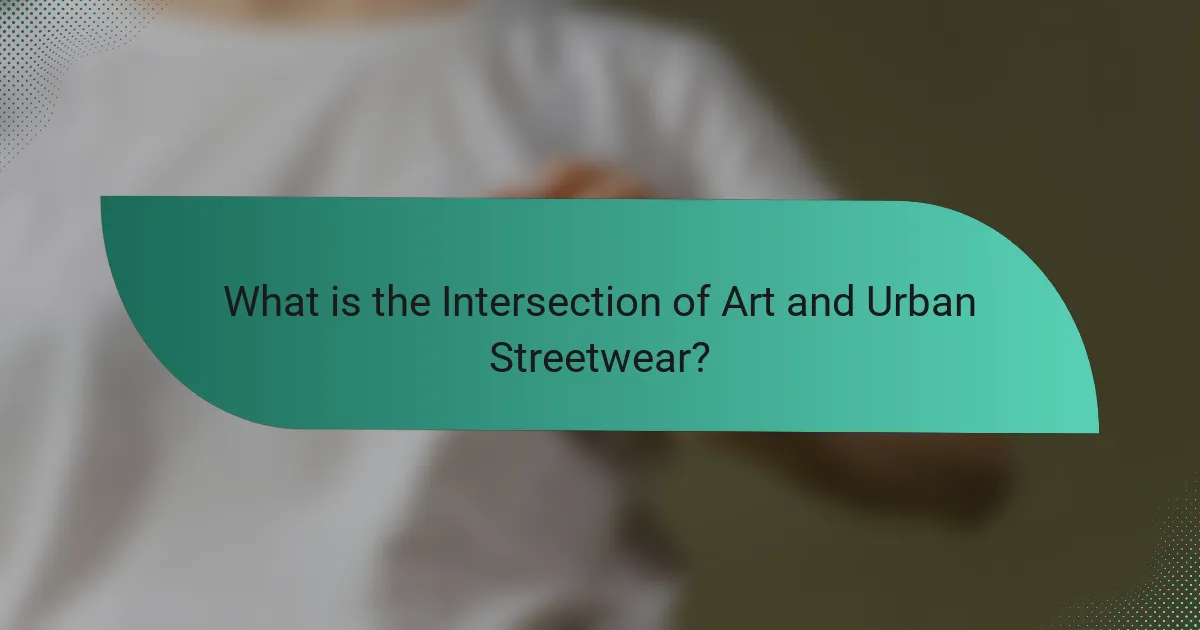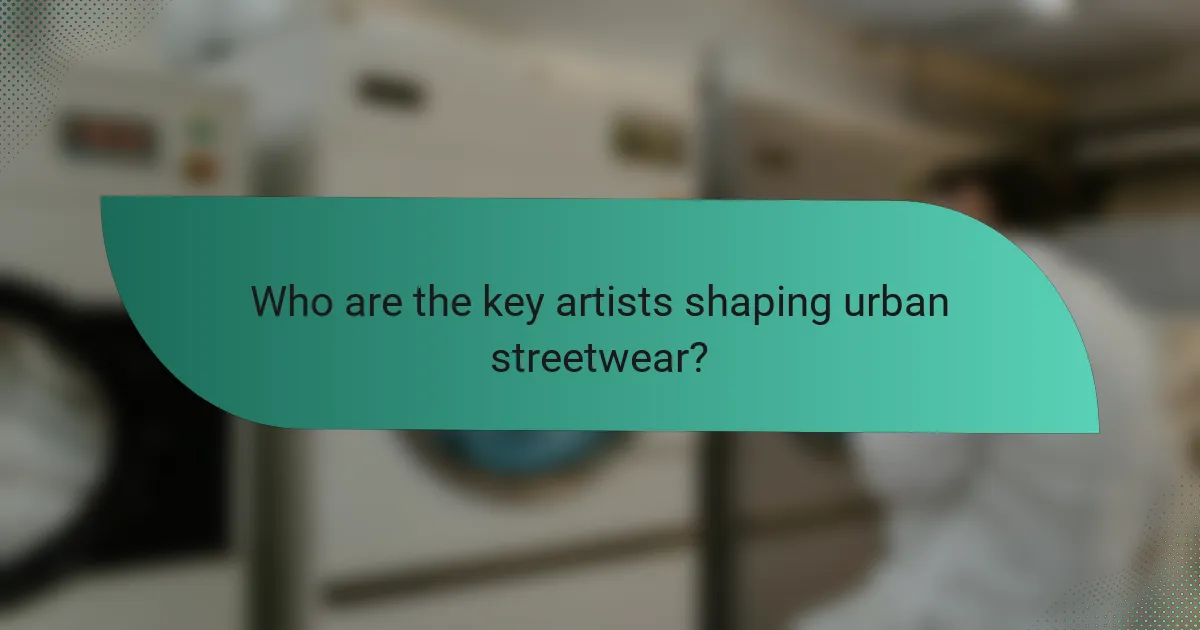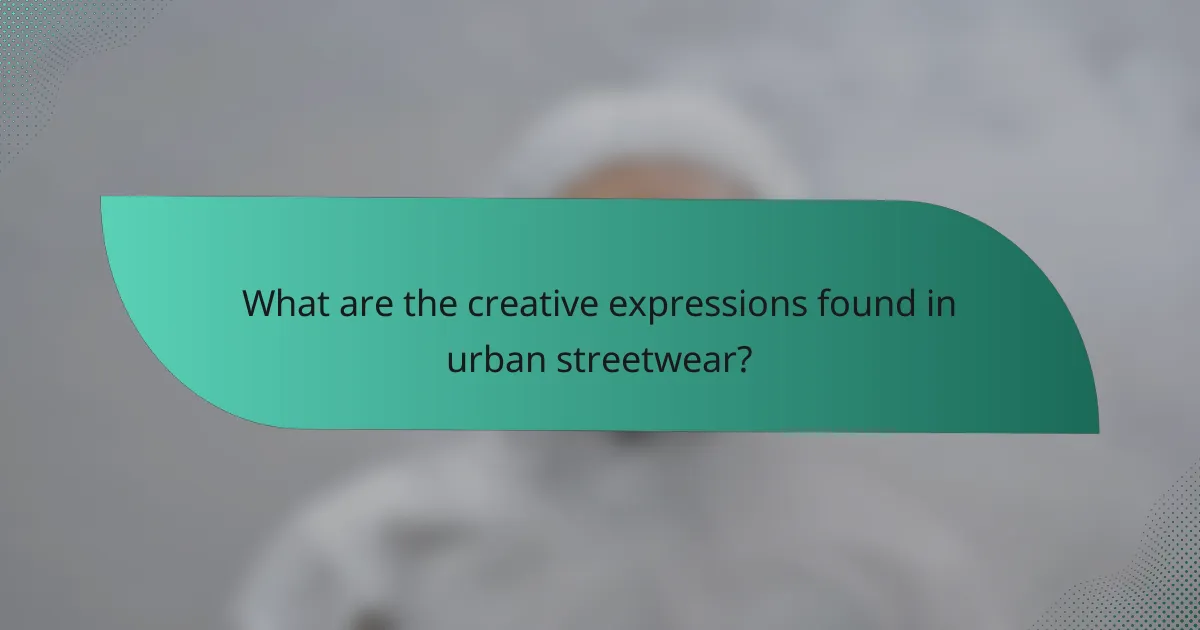
What is the Intersection of Art and Urban Streetwear?
The intersection of art and urban streetwear is a fusion of creative expressions and fashion. Urban streetwear often incorporates artistic elements such as graphics, illustrations, and unique designs. Artists collaborate with streetwear brands to create limited edition pieces. These collaborations elevate the brand’s aesthetic and appeal to a broader audience. Notable partnerships include artists like KAWS and brands like Uniqlo. This blending of art and fashion creates a cultural dialogue. It reflects social issues, identity, and urban culture. The result is a dynamic and evolving fashion landscape that challenges traditional norms.
How do art and urban streetwear influence each other?
Art and urban streetwear influence each other through shared aesthetics and cultural movements. Urban streetwear often draws inspiration from contemporary art, incorporating bold graphics and unique designs. Artists frequently collaborate with streetwear brands to create limited-edition pieces, merging fashion with artistic expression. This collaboration elevates the visibility of both the art and the brand. For example, renowned artists like KAWS and Takashi Murakami have partnered with streetwear labels, creating iconic collections. These partnerships not only enhance the appeal of the clothing but also allow artists to reach wider audiences. Additionally, streetwear serves as a canvas for artistic ideas, reflecting urban culture and social commentary. The interplay between art and streetwear continues to evolve, shaping trends and inspiring new generations.
What are the key elements of urban streetwear culture?
Key elements of urban streetwear culture include unique fashion aesthetics, community influence, and artistic expression. Urban streetwear is characterized by its casual, comfortable clothing often inspired by skate and hip-hop culture. Graphic tees, oversized hoodies, and sneakers are staple items in this fashion genre.
The culture thrives on collaborations between brands and artists, creating limited-edition pieces that reflect individuality. Streetwear often incorporates bold graphics and logos, making statements about identity and social issues. Influential figures in music and art frequently shape trends, driving popularity.
Social media platforms play a crucial role in disseminating streetwear culture, allowing for rapid trend evolution. Events like pop-up shops and fashion shows serve as community gathering points, reinforcing the culture’s social aspect. The blend of fashion, art, and music solidifies urban streetwear as a dynamic cultural movement.
How does art manifest in urban streetwear designs?
Art manifests in urban streetwear designs through the incorporation of graphic prints, vibrant colors, and unique patterns. These elements often reflect cultural influences and social messages. Artists collaborate with streetwear brands to create limited edition pieces. This collaboration enhances the artistic value of the clothing. Streetwear often features artwork inspired by graffiti, pop culture, and contemporary art movements. The use of bold imagery and typography makes a statement on urban life. Additionally, art in streetwear can serve as a form of self-expression for wearers. This trend highlights the connection between fashion and artistic expression in urban environments.
Why is collaboration important in this intersection?
Collaboration is important in the intersection of art and urban streetwear because it fosters innovation and creativity. Artists bring unique perspectives that enhance the aesthetic appeal of streetwear. This synergy creates products that resonate with diverse audiences. Collaborations also bridge cultural gaps, merging different artistic styles and influences. According to a study by the Fashion Institute of Technology, collaborative collections often see increased sales and consumer engagement. This demonstrates the market value of such partnerships. Ultimately, collaboration leads to the creation of distinctive, trend-setting pieces that define urban streetwear culture.
What types of collaborations exist between artists and streetwear brands?
Collaborations between artists and streetwear brands typically include limited edition apparel, art-inspired designs, and co-branded merchandise. Limited edition apparel features unique graphics or styles created by artists. Art-inspired designs incorporate the artist’s signature aesthetic into clothing items. Co-branded merchandise combines the identities of both the artist and the brand, often resulting in exclusive drops. These collaborations often generate buzz and increase brand visibility. For example, the partnership between artist KAWS and the brand Uniqlo produced a highly sought-after collection. Such collaborations enhance the cultural relevance of streetwear. They also provide artists with a platform to reach wider audiences.
How do these collaborations enhance brand identity?
Collaborations between artists and urban streetwear brands enhance brand identity by creating unique, culturally relevant products. These partnerships leverage the artist’s creativity and recognition to attract a wider audience. The integration of art into fashion infuses the brand with a distinct narrative. This narrative resonates with consumers seeking authenticity and individuality. Collaborations often lead to limited-edition releases, fostering exclusivity and urgency. Research shows that brands with artistic collaborations experience increased consumer engagement and loyalty. For instance, the collaboration between Nike and artist Travis Scott significantly boosted brand visibility and consumer interest. Such collaborations position the brand as innovative and trendsetting in the competitive streetwear market.

Who are the key artists shaping urban streetwear?
Key artists shaping urban streetwear include Virgil Abloh, KAWS, and Takashi Murakami. Virgil Abloh was the founder of Off-White and the artistic director at Louis Vuitton. His designs brought high fashion into streetwear. KAWS is known for his distinctive graphics and sculptures, influencing apparel design. Takashi Murakami’s work blends traditional Japanese art with contemporary street culture. These artists have collaborated with major brands, expanding the reach of urban streetwear. Their unique styles and cultural commentary have significantly impacted the fashion landscape.
What styles do these artists bring to streetwear?
Artists bring diverse styles to streetwear, including graphic design, abstract art, and cultural motifs. Graphic design influences often feature bold colors and typography. Abstract art introduces unique patterns and shapes, creating visually striking apparel. Cultural motifs reflect heritage and social commentary, adding depth to designs. Collaborations between artists and brands often result in limited edition pieces that blend artistic vision with fashion. These styles not only enhance the aesthetic appeal but also convey messages and provoke thought within the urban fashion landscape.
How do these styles reflect contemporary cultural themes?
Urban streetwear styles reflect contemporary cultural themes by emphasizing individuality and self-expression. These styles often incorporate bold graphics and unique designs that challenge traditional fashion norms. This approach resonates with the current cultural shift towards authenticity and personal branding. Collaborations between artists and streetwear brands highlight the fusion of art and fashion, showcasing diverse perspectives. The use of sustainable materials in streetwear aligns with growing environmental awareness among consumers. Additionally, streetwear often addresses social issues, making statements about identity and community. This reflects a broader cultural conversation about inclusivity and representation in fashion. Overall, urban streetwear serves as a canvas for cultural commentary and artistic expression.
Which artists have gained prominence in the streetwear scene?
Notable artists who have gained prominence in the streetwear scene include KAWS, Takashi Murakami, and Shepard Fairey. KAWS is known for his distinctive characters and collaborations with brands like Nike and Uniqlo. Takashi Murakami’s vibrant art has influenced collections with Louis Vuitton. Shepard Fairey is recognized for his iconic OBEY brand and political artwork. These artists have significantly impacted the visual language of streetwear and its cultural relevance. Their collaborations have merged high art with fashion, attracting diverse audiences.
What impact do these artists have on consumer trends?
Artists significantly influence consumer trends in urban streetwear. Their unique styles and creative expressions drive brand collaborations. Collaborations often result in limited edition products that generate high demand. For example, artists like KAWS and Jean-Michel Basquiat have partnered with major brands, leading to increased sales. These partnerships enhance brand visibility and appeal to younger audiences. Art-infused designs resonate with consumers seeking individuality. Consequently, consumer purchasing behaviors shift towards products that reflect artistic authenticity. Research shows that 70% of consumers are more likely to buy products associated with artists they admire. This demonstrates the strong correlation between art and consumer trend dynamics.
How do collaborations with artists influence purchasing decisions?
Collaborations with artists significantly influence purchasing decisions by enhancing brand appeal and authenticity. When brands partner with artists, they leverage the artist’s unique creativity and cultural relevance. This collaboration often results in limited-edition products, creating a sense of urgency among consumers. According to a study by the Harvard Business Review, 77% of consumers are more likely to purchase a product if it features an artist they admire. Additionally, collaborations can boost brand visibility through the artist’s established fan base. This expanded reach often leads to increased sales and brand loyalty. Brands that effectively collaborate with artists can differentiate themselves in a competitive market.
What role do social media and marketing play in this impact?
Social media and marketing significantly influence the impact of art in urban streetwear. They serve as platforms for artists to showcase their work to a broader audience. Social media enables real-time engagement between artists and fans. This interaction fosters community and drives trends in streetwear. Marketing strategies amplify visibility for collaborations between artists and brands. These strategies often include targeted advertising and influencer partnerships. Research indicates that 54% of consumers use social media to discover new products. This statistic highlights the importance of social media in shaping consumer behavior in the streetwear market.

What are the creative expressions found in urban streetwear?
Urban streetwear features various creative expressions such as graphic design, textile innovation, and cultural references. Graphic design includes bold logos, intricate illustrations, and typography that convey messages. Textile innovation involves the use of unique materials and sustainable practices. Cultural references draw inspiration from music, art, and social movements. Collaborations with artists enhance the artistic value of streetwear. Limited edition releases often create exclusivity and demand. Streetwear also incorporates elements of graffiti and street art, reflecting urban environments. These expressions collectively shape the identity and evolution of urban streetwear.
How do visual arts integrate into streetwear fashion?
Visual arts integrate into streetwear fashion through graphic designs, prints, and collaborations with artists. Streetwear brands often feature artwork on clothing items, making them wearable art. Collaborations with visual artists create limited edition pieces that enhance brand identity. These partnerships allow artists to reach a broader audience through fashion. The use of bold visuals attracts consumers seeking unique styles. Events like art shows and fashion weeks often showcase these collaborations. This synergy between visual arts and streetwear drives cultural trends and influences consumer behavior.
What artistic techniques are commonly used in streetwear graphics?
Streetwear graphics commonly utilize techniques such as screen printing, digital printing, and embroidery. Screen printing allows for vibrant colors and bold designs, making it a staple in streetwear. Digital printing offers intricate detail and customization, appealing to unique artistic expressions. Embroidery adds texture and depth, enhancing the visual appeal of garments. Other techniques include stencil art, which is often used for its urban aesthetic, and spray painting, which reflects street culture. These methods collectively contribute to the distinctive style of streetwear graphics.
How do these techniques communicate messages or themes?
Techniques in art and urban streetwear communicate messages or themes through visual representation and symbolism. Artists use colors, patterns, and imagery to convey emotions and cultural narratives. Streetwear often incorporates social commentary, reflecting societal issues or movements. Collaborations between artists and brands create a dialogue, merging artistic intent with commercial appeal. For example, graphic designs can challenge norms or celebrate identity. The use of specific symbols can resonate with particular communities, enhancing cultural relevance. This interplay between art and fashion fosters a deeper understanding of contemporary themes. Overall, these techniques serve as a medium for expression and connection.
What are the cultural implications of these creative expressions?
Creative expressions in urban streetwear significantly influence cultural identity and social dynamics. These expressions often reflect the values, struggles, and aspirations of diverse communities. They serve as a platform for marginalized voices, fostering inclusivity and representation. Collaborations between artists and streetwear brands enhance cultural dialogue and innovation. This intersection promotes the exchange of ideas across different artistic disciplines. Moreover, streetwear becomes a medium for social commentary, addressing issues like inequality and consumerism. The global reach of streetwear amplifies local cultural narratives, creating a shared sense of belonging. Historical examples include the rise of hip-hop culture, which shaped fashion and art in urban environments. These creative expressions ultimately contribute to evolving cultural landscapes and redefine contemporary art forms.
How do streetwear designs reflect social movements or issues?
Streetwear designs reflect social movements or issues by incorporating imagery, slogans, and styles that resonate with current cultural conversations. Designers often draw inspiration from protests and activism. For example, brands like Supreme have collaborated with artists to highlight social justice themes. Graphic tees often display messages supporting movements like Black Lives Matter. This form of expression allows wearers to engage with important issues. Historical events, such as the Civil Rights Movement, have also influenced streetwear aesthetics. The use of bold colors and graphics can serve as a visual protest. Overall, streetwear acts as a canvas for social commentary and change.
What role does community play in shaping these expressions?
Community significantly influences the shaping of artistic expressions in urban streetwear. This influence manifests through shared values, cultural backgrounds, and collective experiences. Communities provide a platform for artists to showcase their work, fostering collaboration and creativity. Local trends often emerge from community interactions, guiding the direction of streetwear designs. Artists draw inspiration from the stories and identities of their communities, making their work relatable and authentic. The feedback and support from community members can validate an artist’s vision and encourage further innovation. Additionally, community events, such as art shows or street fairs, create opportunities for artists to connect with their audience, enhancing the cultural dialogue surrounding urban streetwear.
What are some best practices for artists entering the streetwear space?
Artists entering the streetwear space should focus on authenticity and unique style. They must develop a distinctive artistic voice that resonates with their audience. Collaborating with established streetwear brands can enhance visibility. Networking within the streetwear community is essential for opportunities. Artists should stay informed about current trends and cultural movements. Utilizing social media effectively can help build a personal brand. Participating in local events and pop-ups increases exposure. Understanding the business side of streetwear, including production and marketing, is crucial for success.
How can artists effectively collaborate with streetwear brands?
Artists can effectively collaborate with streetwear brands by aligning their artistic vision with the brand’s identity. They should research the brand’s aesthetic and values. This ensures a cohesive partnership that resonates with both audiences. Artists can propose unique designs that reflect their style while incorporating the brand’s elements. Collaborating on limited edition pieces can create exclusivity and drive demand. Engaging in social media promotions amplifies visibility for both parties. Successful collaborations often involve artists participating in marketing campaigns. According to a study by The Business of Fashion, collaborations can increase brand engagement by 30%. This highlights the mutual benefits of such partnerships.
What strategies can artists use to market their designs in streetwear?
Artists can market their designs in streetwear by leveraging social media platforms. Instagram and TikTok are particularly effective for showcasing visual content. Collaborating with influencers can amplify reach and engagement. Participating in streetwear pop-up events creates direct consumer interaction. Limited edition drops generate urgency and exclusivity. Utilizing online marketplaces increases visibility and accessibility. Engaging in community-driven projects fosters brand loyalty. Lastly, storytelling through design enhances emotional connection with the audience.
The main entity of the article is the intersection of art and urban streetwear, which encompasses the fusion of creative expressions and fashion. The article explores how urban streetwear incorporates artistic elements through collaborations with notable artists, enhancing brand identity and cultural dialogue. Key themes include the influence of artists on streetwear trends, the role of community in shaping artistic expressions, and the marketing strategies artists can use within the streetwear space. The content also highlights the impact of social media on consumer behavior and the significance of limited edition releases in driving demand.